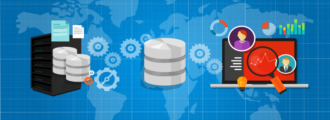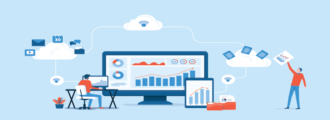Finding a single software solution that seamlessly connects your Human Resources and Payroll operations can feel like a challenge. Fortunately, Human Resource Management System (HRMS) Payroll software provides a solution that manages both functions in one place. By centralizing these critical processes, it significantly reduces the administrative burden on HR staff and improves overall efficiency.
Unlike standalone solutions or basic HR systems, HRMS Payroll software enables easy integration of payroll processing with HR functions, such as compliance and automation. This powerful combination helps you drive better business outcomes by ensuring accuracy and improving the employee experience from hire to retire. Read on to learn more!
What Does HRMS Payroll Management Look Like?
Typically, a cloud-based HRMS has Human Resources Information System (HRIS) elements and Human Capital Management (HCM) abilities. Human Resource Management System (HRMS) Payroll software refers to intelligent solutions that provide single-portal access to both payroll and HR functions, including the integration of benefits administration and payroll records with information and tasks controlled in HR-related systems.
With functional Human Resource Management software solutions, companies can ensure their employees have access to their own information and required tasks and take control of their own processes to improve efficiency, data accuracy, and performance across the board.
An HRMS Payroll system helps employees complete a wide range of tasks, including…
- Reducing the manual workload and time required to complete HR and payroll tasks
- Calculating and paying salaries accurately and efficiently across departments
- Optimizing recruiting, onboarding, talent management, and performance management functions to retain top-tier talent on all internal teams
- Withholding the right amount of deductions and taxes for each employee
- Maintaining employee records to ensure up-to-date and accurate data for employees
- Checking, printing, and delivering paychecks to employees (or depositing pay directly into employee bank accounts through direct deposit functions)
- Managing payroll records, including bank account details and pay frequency, to keep employee compensation data safe and secure
How to Choose the Right Payroll HRMS Software
By understanding the requirements for a new HRMS Payroll solution and considering all relevant factors, like cost, flexibility, extensibility, opportunities for customization, and more, companies can make more informed software decisions and save themselves valuable time and money over time.
Here are a few key steps in choosing the right payroll and HRMS solutions for your teams…
1) Identify requirements for a new system.
When it comes to choosing an HRMS Payroll solution that best fits the needs of your employees and your organization as a whole, identifying your “non-negotiables” (i.e., specific features and capabilities that must be included in the software) is critical to your success.
2) Determine the right solution for your needs.
After you’ve nailed down the necessary requirements for your new system, your team should research possible software solutions to compare the core features, availability, flexibility, and price of each option and ensure you choose the one that’s best for your organization.
Whether you end up going with the full suite of applications within Workday Human Capital Management (HCM) or the comprehensive features of Kronos Workforce Ready, determining the right software vendor for your team is a step that can’t be missed.
3) Outline necessary integrations.
Integrations between human resources and payroll management technology can help organizations ensure more efficient movement of data across teams and avoid data duplication with each solution and its associated areas of the organization.
To ensure you make the most of your technology investments, it’s important to consider any possible integrations between internal HR software and external, payroll-specific systems.
4) Test the software.
Once you’ve made it through all the planning and configuration stages of implementation for your new HRMS Payroll software, you need to ensure the new solution is aligned with core business goals and objectives and check for any potential issues or bugs in the software.
5) Facilitate user adoption across teams.
Now that your new software is configured correctly and your team has thoroughly tested each area to ensure proper functionality, managers and other key stakeholders are responsible for training employees on how to manage their data and complete tasks in the new system.
Key Components of HRMS Payroll Software
Here are a few key components available across HRMS Payroll software solutions…
Payroll Management
By integrating core HR and payroll management functions into a single solution, companies can streamline tax filing processes, expedite compensation planning, and maintain accurate and up-to-date payment information. This ensures that employees are paid on time and accurately for their work.
Employee Self-Service Tools
HRMS Payroll solutions provide an intuitive employee self-service portal that enables employees to manage their own information and complete tasks at their convenience, whether they’re in the office, on the go, or working from home.
With self-service capabilities, employees are enabled to request time off and access current balances, modify information in their employee profile, manage pay stubs, and so much more.
Benefits Administration
HRMS software simplifies benefits enrollment and administration — from helping employees choose the most suitable benefits plan for their needs to managing retirement savings plans, considering deductible rates for health insurance packages, and anything in between.
Main Advantages of HRMS and Payroll Software
Let’s take a closer look at a few key advantages of bringing your human resources and payroll processes together in a single solution…
- Better Data Management: Integrating payroll and HR processes into a single solution helps reduce data errors, saves time required for manual data input, and leverages localization to ensure data security, leading to more accurate and efficient data management processes across teams and areas of the organization.
- Reduced Costs: With one system that includes all your core payroll and HR processes, companies can not only save money by not using multiple different software vendors, but they can also reduce total costs through more efficient business processes and less waste across their entire enterprise.
- Improved Compliance: Cloud-based HRMS software helps ensure compliance with regulatory and legislative requirements by enhancing data management for core compliance functions and keeping employees informed of any potential changes.
- Seamless Integration: With HRMS Payroll software, users are enabled to integrate their core HR and payroll operations, simplifying data and process management and improving business continuity across systems and departments.
- Enhanced User Experience: Flexible solutions and intuitive self-service capabilities make HRMS Payroll software the right choice when aiming to enhance user experiences. HRMS Payroll software allows employees to automate manual tasks and spend their time on more valuable work, giving them greater control over their own experience and improving productivity and satisfaction in the long run.
How Can We Help?
Whether you need help implementing a new Workday Payroll module across your organization, additional support streamlining your time and absence management functions, or just an extra hand completing important tasks across your new HRMS software solution, Surety Systems is here to help.
Our team of senior-level HRMS Payroll consultants has the technical skills and functional knowledge needed to lead you to success, regardless of the complexity of your HR and payroll needs or the nature of your deployment project.
Getting Started with Our Team
Interested in learning where our team of experienced consultants can fit in your organization? Ready to get started on your HRMS Payroll integration journey, but don’t know who to turn to for help? Contact us today for more information!




